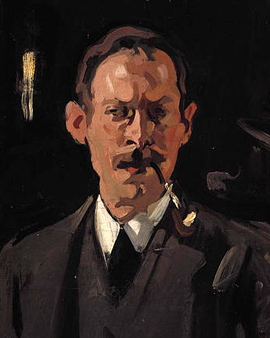


Samuel Peploe, born in Edinburgh in 1871, is regarded as an important representative of the Scottish colorists who are attributed to Late Impressionism. Peploe's colour palette is light and powerful. His subjects include landscapes, places, portraits and still lifes. In terms of composition and technical skill, this is the work of an artist who first completed his academic training at the Edinburgh Art Academy and was then taught at the private academy Julian in Montmartre. In addition, Peploe perfected his knowledge at the Académie Colarossi, another private institute that had the reputation of being modern, even progressive, compared to the Paris Academy of Art: Here, there were male models and female lecturers too!
A stay in Holland in 1895 became a milestone in his career. Here Samuel John Peploe studied and copied the portrait painting of Frans Hals and Rembrandt van Rijn. A trip to France from 1901 onwards was also groundbreaking. Light conditions in nature and the motif captured on the canvas with simple brushstrokes became Peploe's trademark. "Street in Cassis" from 1913 shows the influence of the great French painters on his colleague from Scotland. The "Still Life" with fruit bowl and white jug also shows how the painter was able to capture the light of southern France and the atmosphere of a hot summer day with few means. It is not without reason that this is reminiscent of Paul Cézanne and its declared model Édouard Manet.
From 1910 to 1920 Peploe lived in Paris, concentrating on landscape paintings and still lifes. "Streetscene, Cassis" from 1913 is a fine example of that period with its thick brushstrokes, clear division of areas and magnificent color palette. Even after he returned to Scotland, Peploe continued to focus on clear lines, bright colors and attention to detail.

Samuel Peploe, born in Edinburgh in 1871, is regarded as an important representative of the Scottish colorists who are attributed to Late Impressionism. Peploe's colour palette is light and powerful. His subjects include landscapes, places, portraits and still lifes. In terms of composition and technical skill, this is the work of an artist who first completed his academic training at the Edinburgh Art Academy and was then taught at the private academy Julian in Montmartre. In addition, Peploe perfected his knowledge at the Académie Colarossi, another private institute that had the reputation of being modern, even progressive, compared to the Paris Academy of Art: Here, there were male models and female lecturers too!
A stay in Holland in 1895 became a milestone in his career. Here Samuel John Peploe studied and copied the portrait painting of Frans Hals and Rembrandt van Rijn. A trip to France from 1901 onwards was also groundbreaking. Light conditions in nature and the motif captured on the canvas with simple brushstrokes became Peploe's trademark. "Street in Cassis" from 1913 shows the influence of the great French painters on his colleague from Scotland. The "Still Life" with fruit bowl and white jug also shows how the painter was able to capture the light of southern France and the atmosphere of a hot summer day with few means. It is not without reason that this is reminiscent of Paul Cézanne and its declared model Édouard Manet.
From 1910 to 1920 Peploe lived in Paris, concentrating on landscape paintings and still lifes. "Streetscene, Cassis" from 1913 is a fine example of that period with its thick brushstrokes, clear division of areas and magnificent color palette. Even after he returned to Scotland, Peploe continued to focus on clear lines, bright colors and attention to detail.
Page 1 / 2






